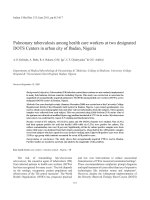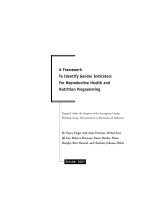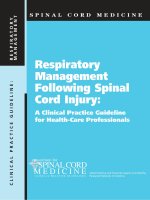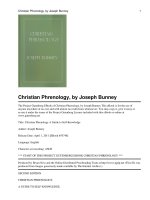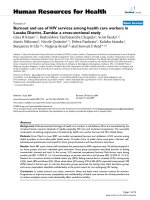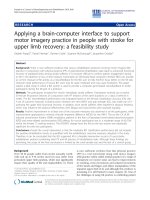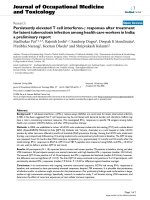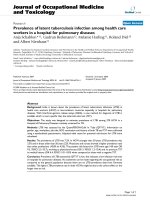A framework to support knowledge sharing practice among health care professionals at yekatit 12 hospital medical college
Bạn đang xem bản rút gọn của tài liệu. Xem và tải ngay bản đầy đủ của tài liệu tại đây (1.13 MB, 87 trang )
ADDIS ABABA UNIVERSITY
SCHOOL OF INFORMATION SCIENCE AND
SCHOOL OF PUBLIC HEALTH
A Framework to Support Knowledge Sharing Practice
among Health Care Professionals at Yekatit 12 Hospital
Medical College
By Betelehem Lema
A Research Project Submitted to the School of Graduate Studies of Addis
Ababa University in Partial Fulfillment of the Requirement for the Degree of
Master of Science in Health Informatics
June, 2017
Addis Ababa, Ethiopia
i
ADDIS ABABA UNIVERSITY
SCHOOL OF INFORMATION SCIENCE AND
SCHOOL OF PUBLIC HEALTH
A Framework to Support Knowledge Sharing Practice
among Health Care Professionals at Yekatit 12 Hospital
Medical College
By
BETELEHEM LEMA
Name and signature of advisors and the examining board members
Advisors
Signature
Date
Dr. Tibebe Beshah
_________________
_______________
Dr. Ayele Belachew
_________________
_______________
Dr. Lemma Lessa
_________________
_______________
Mr. Wondemu Ayele
_________________
_______________
Examiners
ii
Dedication
This work is dedicated to my beloved father Lema Assefa who is always eager to see my academic
success, my beloved mother Mulu Biyadglegne who wants to see changes in my life and did not
get my support at home during the study time, my brothers Kirubel and Surafel Lema and my
sisters Eyerusalem Lema and Meron Teklu.
iii
Acknowledgement
First of all, I would like to thank Almighty God for giving me the patience, courage and strength
I needed to complete this study and for always guiding me in every phase of my life.
My special thanks go to my advisors; Dr. Tibebe Beshah and Dr. Ayele Belachew for their valuable
assistance, feedback, and unreserved support throughout the period of research project.
I am also grateful to Ato Wondemu Ayele (PhD candidate) school of public health, health
informatics coordinator for his support and advice during this research project.
I would also like to express my very profound gratitude to Sr. Emebet Birhanu, Ato Abraham
Adane and Ato Bikis Dagnew and all neonatology staffs for their valuable support and
encouragement throughout my study time and through the process of this research project. I really
thank you.
I would like to thank my friends; Atkilt Michael, Bezahegn Zerihun and Tefera Kune for their
priceless support and encouragement. Sincere Gratitude to Yekatit 12 Hospital Medical College
staffs and study participants for their cooperation during the data collection period.
Last but not least, my special thanks go to my beloved families who were always there supporting
and encouraging me to complete my study.
i
Acronyms and Abbreviations
AOR
Adjusted Odds Ratio
CI
Confidence Interval
HMIS
Health Management Information System
ICT
Information Communication Technology
IT
Information Technology
KM
Knowledge Management
KMS
Knowledge Management System
KS
Knowledge Sharing
OR
Odds Ratio
UK
United Kingdom
USA
United States of America
WHO
World Health Organization
ii
Abstract
Background: - Knowledge is a prime asset of organizations especially in knowledge intensive
organizations like health sector and its management is important for organizational success.
Knowledge sharing is transferring task relevant ideas, information, knowledge and experiences
with other members as well as its retrieval and reuse in the organization. Therefore,
acknowledgement of the importance of knowledge sharing in healthcare organizations will
improve the quality of health care service.
Objective: - The purpose of this research project is to investigate the current knowledge sharing
practice among health professionals so as to propose framework that support knowledge flow
process in yekatit 12 Hospital medical college.
Methods: - A facility based cross sectional mixed qualitative and quantitative study was conducted
among 279 health workers using proportionally stratified random sampling technique. The data
was collected using self-administered structured questionnaire and supplemented with a qualitative
in-depth interviews. The quantitative data was entered and analyzed using SPSS version 20 while
the qualitative data analyzed using thematic approach and presented in the form of narration.
Result: - The study revealed that 53% of the study participants frequently share their knowledge.
More than half of the participants report the absence of motivational schema or system and 60%
of the respondents have high motivational level. Multivariate analysis result indicates that
knowledge sharing of the health care professionals is by 2.87 score more in the presence of
information communication technology with (AOR=2.87; 95% CI= (1.18, 7.007)). Therefore,
information communication technology found to be an independent predictor for knowledge
sharing. Based on the findings of the study a framework that support the knowledge flow process
was proposed. Therefore, framework is designed to enable information technology plays its part
in improving knowledge sharing practice in the hospital to improve the quality of health care
service.
Conclusion: - The study shows that most of the respondents were aware of the importance of
knowledge sharing, engage in active knowledge sharing practice and use face to face
communication and observation as knowledge sharing mechanism in the hospital. And also the
study indicate availability of ICT as independent predictor of knowledge sharing.
iii
Contents
Acknowledgement ........................................................................................................................... i
Acronyms and Abbreviations ......................................................................................................... ii
Abstract .......................................................................................................................................... iii
List of Figures ................................................................................................................................ vi
List of Tables ................................................................................................................................ vii
CHAPTER ONE ............................................................................................................................. 1
INTRODUCTION .......................................................................................................................... 1
1.1.
Background ...................................................................................................................... 1
1.2.
Statement of the problem ................................................................................................. 3
1.3.
Objectives of the research project .................................................................................... 5
1.3.1.
General objective ...................................................................................................... 5
1.3.2.
Specific objectives .................................................................................................... 5
1.4.
Significance of the research project ................................................................................. 5
1.5.
Scope of the research project ........................................................................................... 6
1.6.
Organization of the research project ................................................................................ 6
CHAPTER TWO ............................................................................................................................ 7
LITRATURE REVIEW .................................................................................................................. 7
2.1. Overview .............................................................................................................................. 7
2.2. Knowledge and knowledge management ............................................................................ 7
2.3. Knowledge management life cycle ...................................................................................... 9
2.5. Knowledge sharing model ................................................................................................. 13
2.6. Factor influencing knowledge sharing ............................................................................... 15
2.7. Related works..................................................................................................................... 19
2.8. Conceptual framework of the study ................................................................................... 24
2.9. Chapter Summary .............................................................................................................. 25
CHAPTER THREE ...................................................................................................................... 27
METHODOLOGY ....................................................................................................................... 27
3.1. Study area........................................................................................................................... 27
3.2. Study design ....................................................................................................................... 27
3.3. Source Population .............................................................................................................. 27
3.4. Study Population ................................................................................................................ 28
3.5. Sample size and Sampling procedure ................................................................................ 28
iv
3.6. Sampling Technique and Procedure .................................................................................. 29
3.7. Data collection methods ..................................................................................................... 30
3.8 Data Processing and Analysis ............................................................................................. 30
3.9. Data quality management .................................................................................................. 30
3.10. Inclusion and Exclusion criteria....................................................................................... 31
3.11. Study Variables ................................................................................................................ 31
3.12. Design and evaluation of the framework ......................................................................... 32
3.13. Operational Definitions .................................................................................................... 32
3.14. Measurements .................................................................................................................. 33
3.15. Ethical Considerations ..................................................................................................... 34
CHAPTER FOUR ......................................................................................................................... 35
RESULT AND DISCUSSION ..................................................................................................... 35
4.1. Results of quantitative study .............................................................................................. 35
4.2. Results of qualitative study ................................................................................................ 51
4.3. Discussion .......................................................................................................................... 53
4.4. The proposed knowledge sharing Framework ................................................................... 56
4.5. Evaluation of the framework ............................................................................................. 59
4.6 Strength and Limitation of the Research Project ................................................................ 60
CONCLUSION AND RECOMMENDATION ............................................................................ 61
5.1. Conclusion ......................................................................................................................... 61
5.2. Recommendations .............................................................................................................. 62
References ..................................................................................................................................... 64
ANNEXES
v
List of Figures
Figure 1: Knowledge management cycle ...................................................................................... 11
Figure 2: SECI model for KS........................................................................................................ 14
Figure 3: Conceptual framework to analyze the determinants of knowledge sharing .................. 24
Figure 4: knowledge sharing practice of the health care professionals in Yekatit 12 Hospital
Medical College, Addis Ababa, 2017 ........................................................................................... 37
Figure 5: Motivational level of the respondents in Yekatit 12 hospital medical college, Addis
Ababa, Ethiopia, 2017................................................................................................................... 39
Figure 6: Presence of motivational scheme or system in yekatit 12 Hospital medical college, Addis
Ababa, Ethiopia, 2017................................................................................................................... 39
Figure 7: The proposed framework to support knowledge sharing among health care
professionals at Yekatit 12 Hospital Medical College ................................................................ 58
vi
List of Tables
Table 1: Related works summary ................................................................................................. 26
Table 2: Socio Demographic characteristics of the respondent in Yekatit 12 Hospital Medical
College, 2017, Addis Ababa, Ethiopia, n= 279 ............................................................................ 36
Table 3: Combination usage of Knowledge sharing mechanism in Yekatit 12 Hospital medical
college, Addis Ababa, 2017 .......................................................................................................... 38
Table 4: Trust among health care professionals in yekatit 12 Hospital medical college, Addis
Ababa, 2017 .................................................................................................................................. 41
Table 5: Health care professionals knowledge sharing awareness in Yekatit 12 hospital medical
college, Addis Ababa, 2017 .......................................................................................................... 42
Table 6: Health care professionals personality in Yekatit 12 Hospital Medical College, Addis
Ababa, 2017 .................................................................................................................................. 43
Table 7: Intrinsic motivation of health care professionals in Yekatit 12 Hospital Medical college,
Addis Ababa, 2017........................................................................................................................ 44
Table 8: Administrative support for knowledge sharing in Yekatit 12 medical college, Addis
Ababa, 2017 .................................................................................................................................. 45
Table 9: Organizational arrangement for knowledge sharing in Yekatit 12 hospital medical college,
Addis Ababa, 2017........................................................................................................................ 46
Table 10: Extrinsic motivation of health care professionals in Yekatit 12 hospital medical college,
Addis Ababa, 2017........................................................................................................................ 47
Table 11: Health care professionals team work for knowledge sharing in Yekatit 12 hospital
medical college, Addis Ababa, 2017 ............................................................................................ 47
Table 12: Technological factors in Yekatit 12 hospital medical college, Addis Ababa, Ethiopia,
2017............................................................................................................................................... 49
Table 13: Association between socio demographic variable and knowledge sharing in Yekatit 12
Hospital Medical College, Addis Ababa, 2017 ............................................................................ 50
Table 14: Crude and Adjusted Odds ratio for knowledge sharing practice and selected variables in
yekatit 12 Hospital Medical College, Addis Ababa, 2017............................................................ 51
vii
CHAPTER ONE
INTRODUCTION
1.1.Background
These days global competitions are increased in every business and the society become more
knowledge based. Therefore the organizations that can identify, value, create and evolve their
knowledge assets are likely to be more successful than those that do not. Knowledge in a modern
organization is an essential resource especially because it is not readily replicated by rivals (1).
Knowledge is defined as human expertise, which is found in peoples mind and gained through
experience, interaction and the like. Nonaka distinguishes two main kinds of knowledge: tacit and
explicit. Tacit knowledge is the personal, unarticulated, unexpressed knowledge possessed by an
individual. It is the knowledge and expertise that a person has gained over the years through
experience, by interacting with others, and through a process of trial and error. This knowledge
lies in the individual’s brain. Generally found in non-structured form, such as an individual’s ideas,
insights, values, experiences and judgments, it is more difficult to identify and to manage. Thus, it
needs to be structured before it may be stored and processed. On the other hand, explicit knowledge
is a knowledge that can be explicated, codified and set down in manuals, written procedures,
records, notes, and graphic representations, audio and visual materials. Stored in databases, explicit
knowledge is suitable for access and processing (2).
Knowledge management is the deliberate and systematic coordination of an organization’s people,
technology, processes, and organizational structure in order to add value through reuse and
innovation. This is achieved through the promotion of creating, sharing, and applying knowledge
as well as through the feeding of valuable lessons learned and best practices into corporate memory
in order to foster continued organizational learning (3).
The health care industry is increasingly becoming a knowledge-based community that depends
critically on KM activities to improve the quality of care. Utilizing KMS to manage medical
information and health care knowledge to support the full spectrum of knowledge needs in the
medical process has become an important issue for health professionals (3).
1
World Health Organization (WHO) defines knowledge management as “a set of principles, tools
and practices that enable people to create knowledge, and to share, translate and apply what they
know to create value and improve effectiveness” (4).
Knowledge sharing is transferring or sharing task relevant ideas, information and suggestions or
the behavior of disseminating and transferring knowledge with other members, within one’s
organization. The availability of shared knowledge is necessary for adapting, extending and
creating new knowledge and innovation. Effective knowledge sharing involves the dissemination
and transfer of knowledge as well as its retrieval and reuse. In the process of sharing knowledge,
people are the primary entity. This is because knowledge usually exists in the mind of individuals.
The process of sharing knowledge often starts at the individual level, and expands to the group
level and the organizational level. Such a process of sharing organizational knowledge facilitates
the exchange of working experiences, technical know-how and individual insights between and
among individuals. Knowledge sharing increases the organizational knowledge and improves the
capability of its employees for performing their jobs better. The basic purpose of communicating
knowledge with in a group is to utilize the available knowledge and improve group performance
(5, 6).
Since health care industry is knowledge intensive, it deals with patients’ lives and wellness. If the
knowledge in this industry is not shared the benefit will be limited. There is clear understanding
among the health care managers and practitioners about the transformation of health care industry
towards knowledge based industry (7). Healthcare organizations have recently realized that
medical knowledge not only needs to be managed but also shared among professionals and
patients. Inadequate knowledge sharing in healthcare organizations can lead to medical errors.
Thus, knowledge sharing in healthcare industry may no longer be a “nice to have” process but
changes into a “must have” one. Acknowledgement of the importance of knowledge sharing in
healthcare organizations has resulted creating, sharing and using knowledge to improve the health
care service quality and reduce cost (8).
Healthcare organizations should have the culture of knowledge sharing practices to make better
use of the know-how, experiences and skills of their healthcare professionals. So, having a KS
culture enables the healthcare workers to implement their best practices and generate new ideas
and better quality healthcare service can be delivered (9).
2
1.1.1. Overview of Yekatit 12 Hospital Medical College
Yekatit 12 Hospital Medical College was established by Emperor Hileselase in 1915 E.C. At that
time the hospital was called “Betesida beteferi mekonnen” and it had only 25 beds. Since, 1987
the hospital become under Addis Ababa bureau.
The hospital is located in Arada Sub City, Worde 06. Yekatit 12 hospital medical college is a
referral teaching hospital and it starts teaching medical doctors’ since 2003 E.C. It used as a referral
center for 16 catchment area health centers and other private clinics/ hospitals. It gives around 36
services as an inpatient and outpatient such as delivery service, dental, plastic surgery service for
burn and cleft lip and palate, neonatal intensive care, adult intensive care, speech therapy,
psychiatry services and so on with 355 beds. Yekatit 12 Hospital medical college has a total of
1134 technical and supportive staff among them 664 of them are health professionals and the rest
466 are supportive staffs.
1.2.Statement of the problem
Healthcare is experiencing an exponential growth in the scientific understanding of diseases,
treatments and care pathways. As a consequence, healthcare knowledge is in flux new healthcare
knowledge is being generated at a rapid pace and its utilization can profoundly impact patient care
and health outcomes. But, this growth of knowledge is not congruent with our ability to effectively
disseminate, translate and apply current healthcare knowledge in clinical practice (10).
According to the Lin and Hsieh, “delivering safe and high quality services to patients is highly
dependent on sharing the following types of knowledge, i.e. medical knowledge, scientific
knowledge, incident knowledge, and experience knowledge”. Medical knowledge is defined as the
required information for diagnosis and treatment. Scientific knowledge is about applying research
findings in practice. Incident knowledge refers to learn from medical errors. Finally, experience
knowledge refers to experienced healthcare providers educate less experienced practitioners about
the best practice procedures. Failure to share the above mentioned knowledge can impact patient
safety. Thus, all these types of knowledge require special attention, in order to create an
environment to improve the quality of healthcare services (8).
Many healthcare organizations are facing lack of knowledge sharing due to absence of processes
and framework for knowledge management. As a result, they face difficulties while acquiring the
knowledge due to its rapid growth. One of the existing problems in healthcare knowledge
3
management is lack of knowledge sharing culture; departments within healthcare have no such
contact with each other where both can share their knowledge. This problem leads them towards
the narrow vision of knowledge and as a consequence, it becomes difficult for healthcare
organization to work as a group. This problem leads organization to the falling of efficiency and
customer satisfaction (11).
According to the estimation of US medicine institute around 98,000 patients die each year as a
consequence of preventable errors. Also, a study conducted in two UK hospitals shows that 11%
of admitted patients experienced adverse events of which 48% of these events were most likely
preventable if the right knowledge was applied. The conclusion drawn from the above studies is
that the under-utilization of healthcare knowledge contributes to incorrect clinical decisions,
medical errors, sub-optimal utilization of resources and high healthcare delivery costs (10).
Previous studies conducted in Ethiopia indicated lower level of knowledge sharing practices
among health professionals due to several reasons like, lack of opportunity for knowledge sharing,
lack of interest to share (openness). The studies also shows that there is lack of formal knowledge
sharing opportunities, lack of integrated knowledge sharing with the hospital work process and
lack of infrastructures that help to facilitate knowledge sharing practices. The majority of
respondents are not motivated to share knowledge and poor management support of the KS activity
of the hospital (12, 13 and 14).
By observing the hospital knowledge sharing practice it faces the problem that mentioned in the
above studies. In Yekatit 12 hospital medical college there are knowledge sharing practices like
(seminars, morning sessions) which encompasses doctors or specialists but the hospital does not
have structured framework that comprises different types of health care professionals to share
their knowledge, skill and practice to give a quality care to patients. The hospital knowledge
sharing practice is not putted in an integrated way, not supported by KS supportive infrastructures,
and there is poor KS practices between different departments. Therefore, the aim of this research
project is to identify the challenges of knowledge sharing and to propose a framework that support
the knowledge sharing environment among healthcare professionals in yekatit 12 Hospital medical
college.
At the end, this research project will attempt to answer the following study questions:-
4
What does the current knowledge sharing practices in yekatit 12 Hospital medical college
look like?
What are the challenges of current knowledge sharing among healthcare professionals?
How factors can be mapped to knowledge sharing framework?
How to evaluate the proposed knowledge sharing framework?
1.3.Objectives of the research project
1.3.1. General objective
The purpose of this research project is to investigate the factor that influence the current
knowledge sharing practice among health care professionals in order to design a framework
that support knowledge flow and reuse in yekatit 12 hospital medical college.
1.3.2. Specific objectives
To identify the current knowledge sharing practice among health professionals in yekatit
12 hospital medical college.
To identify the factors that influence knowledge sharing practice among health
professionals in yekatit 12 hospital medical college.
To map contextual factors into framework for knowledge sharing practice among
healthcare professionals in yekatit 12 hospital medical college.
To evaluate the designed framework of knowledge sharing in yekatit 12 hospital medical
college.
1.4. Significance of the research project
The availability of accurate and timely knowledge enables organizations to create high quality
services, products, and processes. The health care industry is knowledge intensive industry, most
of this knowledge resides in the heads of health care professionals. In healthcare organizations,
medical decision depends mostly on experience and knowledge of health professionals. Thus,
facilitating the interaction, integrating, sharing and making this knowledge available to healthcare
professional will improve health care delivery and decision making.
The research project help to identify the challenges and current knowledge sharing practice of the
health professional and to design a contextual knowledge sharing framework. Identifying the
challenges will enable the hospital to take measure on the contextual challenges and also the
5
proposed KS framework would help as a road map to design and implement healthcare knowledge
management system which enhance KS practice of healthcare professionals and improve
healthcare quality.
1.5.Scope of the research project
Knowledge management covers knowledge creation, capturing, representation and sharing.
However this research project is going to be conducted only in the context of knowledge sharing.
Knowledge sharing occurs at individual, departmental, organizational, intra organizational levels
and facilitated by ICT. In this project individual, organizational and technology factors affecting
knowledge sharing are investigated and it is delimited to factors proposed in the conceptual
framework. Therefore, this research project is conceptual by its nature and aims to propose a
framework to support knowledge sharing practice among health professionals in yekatit 12
Hospital medical college.
The reason for selecting Yekatit 12 Hospital Medical College as a research project case is that it
is one and only hospital under Addis Ababa health bureau that teaches medical doctors. Therefore,
the health professionals should have an up-to-date knowledge. This knowledge is going to be
shared among the health professionals to improve health care quality and to have a knowledgeable
students that serve the country in the future.
1.6.Organization of the research project
This research project is organized into five chapters. Chapter one discusses about the background
of the research, research problem, research objectives and significance of the research. Chapter
two discusses about knowledge, knowledge sharing, and factors of knowledge sharing, the findings
of related works and the conceptual framework. Chapter three presents the research method
employed to answer the research questions stated in Chapter one. It describes research procedures,
data collection instruments and data analysis techniques. Chapter four focuses on results of the
empirical data analysis on knowledge sharing among health care professionals and present and
describe the proposed KS framework. The last Chapter presents the conclusion and
recommendation for future research work.
6
CHAPTER TWO
LITRATURE REVIEW
2.1. Overview
This chapter present a review of different literatures concerning knowledge sharing among health
care professionals and factors that influence their knowledge sharing behavior of the health care
professionals. Reviewing a literature provides an up-to-date understanding on the research topic,
identify gaps/limitations in current state of knowledge, prevent repeated errors occurrence, and
help to develop research questions for the topic, provide readers with a coherent, focused summary
of current state of knowledge.
The literature review of this research project try to observe what knowledge and knowledge
management, knowledge management lifecycle: knowledge creation, structuring, dissemination
and application, knowledge sharing in health organization, the influencing factors of KS
categorizing in to individual, organizational and technological factors and different research which
are related with the research topic are going to be discussed to support the research project and
finally the literature review is going to be summarized.
2.2. Knowledge and knowledge management
Davenport and Prusak defines knowledge as a fluid mix of framed experience, values, contextual
information, and expert insight that provides a framework for evaluating and incorporating new
experiences and information. It originates and is applied in the minds of knowers. In organizations,
it often becomes embedded not only in documents or repositories but also in organizational
routines, processes, practices, and norms (15).
Knowledge comes from information processed by using data. It includes individuals’ experiences,
values, insights, and contextual information and helps to evaluate and incorporate new experiences
and information. Knowledge originates from and is applied by knowledge workers. People use
knowledge in making decisions. Recently, organizations realized that as they own massive amount
of knowledge and that this knowledge needs to be managed (16).
Knowledge is an important strategic resource for all organizations. It could help organizations to
gain competitive advantage. In health care, knowledge is the main assets of the organizations
because it enables the organizations to accomplish best medical results. In recent times, healthcare
organizations are attempting to build and enhance the use of owned knowledge (17).
7
Knowledge in an organization has two perspective (18): Tacit knowledge is personal, which is
stored in the heads of people. It is accumulated through study and experience. Tacit knowledge
grows through the practice of trial and error and the experience of success and failure. Tacit
knowledge is deeply rooted in action, procedure, routines, commitment, values and emotions. It is
intangible and not easy to articulate, making it difficult to share with others. Tacit knowledge can
be shared and communicated through various activities and mechanisms. Activities include
conversations, workshops, on-the-job training and the like. Mechanisms include, the use of
information technology tools such as email, groupware, instant messaging, web portal and related
technologies.
Explicit knowledge comprises of knowledge that is codified, documented and archived on a paper
or paperless media (like database). These include knowledge assets such as reports, memos,
business plans, drawings, patents, trademarks, customer lists, methodologies, and the like. They
represent an accumulation of the organization’s experience kept in a form that can readily be
accessed by interested parties and replicated if desired. In many organizations these knowledge
assets are stored with the help of computers and information technology. Explicit knowledge has
a tangible dimension that can be more easily captured, codified and communicated. It can be
processed, transmitted and stored relatively easily (18).
Healthcare knowledge is central to clinical decision making throughout the diagnostic-therapeutic
cycle. The knowledge is applied to arrive at correct diagnostic decisions and to derive the most
effective therapeutic regimes. To made Clinical decisions the healthcare professional applies
knowledge to validate prior hypothesis and satisfy a few more constraints to get closer to the final
decision. Healthcare knowledge is dynamically contextualized to interpret the patient’s evolving
health status, and to derive treatment interventions that will work for a specific patient in a specific
healthcare setting. Therefore, the key to successful clinical decision-making is the timely
availability of correct and relevant knowledge with respect to the clinical context (10).
Knowledge Management (KM) is the process by which people in organizations capture, share, and
generate knowledge for action. It is one of the key elements in improving organizational
effectiveness and efficiency. Thus, organizations that are capable of generating new knowledge,
managing it, and applying it effectively will be successful at creating a competitive edge (22).
8
Knowledge management (KM) become very important in the 1990’s because it will help
organization to have competitive advantage and effective work through sharing and re-use of
knowledge in an organization. Knowledge should be managed properly in an organization due to
information
overload,
technology
advancement,
increased
professional
specialization,
competition, workforce mobility and turnover, and capitalize on organizational knowledge (16).
Different perspectives of knowledge create different perspectives of knowledge management. If
knowledge is seen as an object or an access to information, then knowledge management should
pay attention to knowledge store and manage it. If knowledge is seen as a process, then knowledge
management should focus on creation, sharing and using this knowledge. In this case, knowledge
management needs to meet organization needs by exploiting and determination existing
knowledge and thus creating a new knowledge. Knowledge management should pay attention to
a human factor if knowledge is seen as an object. According to Davenport & Prusak, KM has three
main mostly used aims: Make knowledge visible, show and determine a role of knowledge in
organization, develop a culture by managing employee’s behavior and design a connection
between employees; create spaces, tools, time for employees. To encounter the aims and
organizational needs knowledge management provides a framework, which helps an organization
to create and share knowledge. For an organization it is important to capture and to share
knowledge in an effective way in order to obtain more profits (23).
Knowledge management in health care is aligning people, processes, data and technologies to
optimize information, collaboration, expertise, and experience in order to drive organizational
performance and growth and characterized as, modeling the systematic creation, sharing
operations, and the translation of health knowledge to improve the quality of patient care. The
purpose of the health care knowledge management is to promote and provide optimum health
knowledge, timely, effective and pragmatic for health professionals (and even to patients and
individuals) where and when they need to help them create high quality, well-informed and cost
effective patient care decisions (10, 22).
2.3. Knowledge management life cycle
Knowledge management cycle consists four processing steps (24): namely, knowledge creation,
knowledge structuring, knowledge transferring or disseminating and knowledge application.
9
2.3.1. Knowledge creation process
Knowledge creation process concerned with creating new tacit and explicit knowledge which are
embedding in organization’s products, services and work processes after creating (25).The
knowledge creation process includes knowledge acquisition and knowledge representation.
Knowledge can be created from several sources and methods such as research and development
center, organizational learning outcomes, lessons-learned analysis and innovation. The knowledge
acquisition method is both internal and external sources, need to be developed. The knowledge is
represented using the formal representation methods developed by the organization for processing
(24).
2.3.2. Knowledge structuring process
The knowledge structuring process includes defining, storing, categorizing, indexing, and linking
digital objects such as documents and images to knowledge units. The idea of mapping the existing
and available knowledge including expertise and skills in terms of its context, relevance, and
locations helps in the classification of the organization knowledge. A proper storage of knowledge
with proper indexing and linking with other relevant knowledge for example company yellow
pages of experience and knowledge, skill development and company training materials. The
classification system groups similar documents together and fits them into relevant categories,
which can be generated by manual or automated means, or a combination of the two (24, 26).
2.3.3. Knowledge transferring or disseminating process
Knowledge dissemination process consists of different techniques and methods of knowledge
sharing and collaboration. Knowledge presentation which includes searching (pulling) and
providing (pushing) relevant content automatically to the user on the basis of user requirements.
Knowledge sharing is done using different means, some of which are automatic and some manual,
such as training and education, company intranet, communities of practice, external or internal
benchmarking, documentation and newsletter, and cross-functional teams (26).
2.3.4. Knowledge application process
The knowledge application process involves applying, which includes retrieving and using,
knowledge in support of decisions, actions, problem-solving, developing competency maps to
place people in best jobs and teams for improving productivity, establishing communities of
10
interest, automating routine work or workflow, and training the people to meet the requirements
of current issues (26).
Figure 1: Knowledge management cycle
2.4. Knowledge sharing in health care organization
According to the WHO “A health system consists of all organizations, people and actions whose
primary intent is to promote, restore or maintain health” (19). Healthcare organizations are
composed of health care professionals from multiple disciplines forming several interconnected
care teams that attempt to provide safe and consistent care (20). The care teams have to coordinate
and communicate amongst their team members and with other teams to function in a cohesive
manner to execute the highly coordinated and high risk activity that is called patient care. Health
care organizations have to be able to modify their activities based on sudden changes in the
condition of their patients or sudden demands due to public health disasters without compromising
11
patient safety or quality of care. New knowledge creation, technology advances and other market
changes can add new and unexpected demands in health care delivery. Health care organizations
have to maintain stability following institutional protocols but have to assess their performance
and evaluate protocols to create and incorporate new knowledge. The created and incorporated
new knowledge should be managed and shared among the health professionals (21).
Knowledge sharing has become an essential part of knowledge management. The ultimate goal of
KS is to distribute the right content to the right people at right time. The system therefore must
enable us quickly and effectively to find relevant information & expertise and that can aid into
decision-making & problem solving. Hence, the tacit knowledge resides in the minds of
individuals, in their skills, experiences, value judgments (8).
Knowledge Sharing is an interactive practice of disseminating reliable knowledge, to the right
people at the right time, in an intelligible way that allows them to act carefully and to enrich the
organization’s knowledge base (27).
Knowledge sharing among individuals enables work groups to enhance competency and mutual
generating new knowledge. This results in a synergistic effect. That is, social capital is created as
those who share knowledge improve their knowledge by dialogue and those who receive
knowledge learn. Furthermore, this implies that organizations need to assist employees to become
conscious of tacit knowledge (28).
Knowledge sharing is the key to health care organization for patient care. Once knowledge is
created there is health care quality that results from its sharing both because more than one
individual can use knowledge at the same time and shared knowledge stimulates the creation of
new knowledge (29).
Knowledge sharing is important in industries where knowledge is a key asset like healthcare
organizations. The healthcare industry is a knowledge rich community which deals with patients’
lives and wellness. Losing the opportunity of having the right knowledge at the right time can lead
to medical errors. Therefore, knowledge sharing is a must in healthcare organizations (8).
From a healthcare knowledge management (KM) perspective it is vital to join and facilitate tacit
knowledge sharing among clinical teams. Sharing knowledge in health care can be characterized
as an explanation and dissemination of health knowledge by and for health care stakeholders
12
through a collaborative communication tool for advancing knowledge of health stakeholder
participated intelligences. Healthcare organizations should have the culture of knowledge sharing
practices to make better use of the knowhow, experiences and skills of their healthcare
professionals. As a result, the healthcare workers enable to implement their best practices and
generate new ideas and better healthcare quality service can be delivered (14).
Generally, knowledge sharing is a people to people process to exchange knowledge. For an
organization, it is very important to have employees, who are willing to share knowledge and are
motivated to do this. An employee could improve her/his ability by using ideals and experiences
from co-workers. Cabrera and Cabrera argue that when an employee shares knowledge, he or she
does not lose this knowledge as “knowledge is not commodity”. Sharing knowledge has a cost
which is based on a cost of realizing the sharing process (for instance, providing tools,
documentation, group meetings etc.) (32).
2.5. Knowledge sharing model
According to Nonaka and Takeuchi (2), knowledge sharing is a process of interactions between
explicit and tacit knowledge. The interactions between tacit and explicit knowledge lead to the
creation and sharing of new knowledge. Nonaka developed SECI model, which includes four
modes of knowledge conversion: socialization, externalization, codification and internalization.
Although this model is originally developed for knowledge creation, it is also used to study
knowledge sharing processes (45). The arrows in Figure 2 show knowledge conversion from tacit
to explicit and back to tacit knowledge.
Socialization – is the process of creating common tacit knowledge through shared experiences. In
socialization, a field of interaction is built where individuals share experiences and space at the
same time. Through this process common unarticulated beliefs and embodied skills are created
and developed. It uses observation, demonstration and apparent ship to share knowledge (18).
Externalization – is the conversion of tacit knowledge into observable knowledge assets. The
knowledge shared in social settings is documented and converted into explicit knowledge that is
shared through publicly accessible media (such as articles, books and audiovisual materials). Here
the tacit knowledge in the brains of experts are articulated and expressed as concepts or drawings,
thus becoming explicit knowledge that can be further studied and refined (2).
13
Combination – is a process of assembling new and existing explicit knowledge into a systemic
knowledge (18).What commonly occurs is the combination of a newly created concept with
existing knowledge to produce something tangible (e.g., a new product model). Individuals receive
new knowledge and combine it with their own experience and former knowledge to expand their
knowledge base (2).
Internalization – refers to conversion of explicit and tacit knowledge into personal knowledge.
This is a process of embodying explicit knowledge to tacit knowledge explicit knowledge is shared
throughout the organization and then converted into tacit knowledge by individuals. It is very much
related to learning by doing, for example through; training programs, simulations and experiments
(2).
Figure 2: SECI model for KS
Source: (Nonaka and Tekuechi, 1995)
14
2.6. Factor influencing knowledge sharing
One of the major barrier to effective knowledge management has proven to be the absence of
knowledge sharing. More specifically, sharing employees’ skills and expertise is likely to enhance
organizational capabilities in knowledge management and renewal, and consequently to produce
more than desirable work outcomes. Knowledge sharing can occur through written correspondence
or face to face communications via networking with other experts, or documenting, organizing and
capturing knowledge for others (30, 31).
A number of factors impact employees’ perception of a knowledge sharing culture. The identified
factors can be broadly categorized into three groups: individual or human factors, organizational
factors and technological factors. Identifying the factors help organizations to control their
knowledge asset, first they must understand factors that affect KS at individual level. Also
knowledge sharing takes place in the organization and to facilitate the knowledge sharing process
ICT plays an important role.
2.6.1 Individual factors
The success of any knowledge management depends on the communication among individuals,
particularly sharing knowledge among the individuals. Knowledge sharing is related to the
willingness and readiness of individuals to share their knowledge with others. However, effective
knowledge sharing among individuals depends on the individual knowledge sharing behavior.
Therefore, organization may focus on the individual factors that influence knowledge sharing
behavior of individuals to have successful knowledge sharing initiatives. Trust, awareness,
personality and intrinsic factor of motivation categorized as individual factor (17).
2.6.1.1. Trust
Trusting relationship is important between employees, participants to share and transfer
knowledge. A trust plays a great role in knowledge management. An organization and a team
group should create a trusting relationship in order to achieve company’s goals in an effective way
(33). Trust among employees will promote active KS behavior. Such active KS behavior enhances
effective communication by empowering members or an organization to freely share personal
knowledge and concerns. The high levels of employee trust can lead to better knowledge sharing
and shared goals (34).
15
